ADD/ADHD Therapy: How does Tomatis® help?
Do you or your child struggle with focus, fidget while listening, get easily distracted, make careless mistakes, have trouble waiting your turn, or speak out of turn? You're not alone. Over 366 million adults and 129 million children have ADD/ADHD globally, making it one of the most common diagnoses today, regardless of age, social status, intelligence, or gender. Let’s discover how the Tomatis® Method could complement your ADD/ADHD therapy.
What is ADHD? Why start ADHD Therapy?
Informed by neuroscience, brain imaging, and clinical research, it is crucial to recognize that ADHD is not a behavioural disorder, neither a mental illness, nor a specific learning disability. Rather, it is characterised as a developmental impairment of the brain’s self-management system. Individuals with ADHD encounter challenges with impulse control, concentration, and organizational skills. Understanding this distinction is essential to approach ADHD with the appropriate perspective and ensure the most effective support and interventions for those impacted by this condition.
ADHD therapy like Behavioural therapy and Cognitive Behavioral Therapy (CBT) is designed to enhance an individual’s capacity to concentrate, control impulses, and effectively manage hyperactivity, ultimately leading to an improved quality of life. Though not a standalone program, the Tomatis® Method, a neurosensory training approach involving the ear, brain, and body, presents a non-intrusive and natural option that can complement ADHD therapy, further enhancing the outcomes for users.
The difference between ADD and ADHD
ADD (attention deficit disorder) and ADHD (attention deficit hyperactivity disorder) are terms often used interchangeably, but they refer to different aspects of the same condition. ADHD is a neurological disorder encompassing both hyperactive and inattentive subtypes. ADD, though no longer a medical diagnosis, is commonly used to describe the Predominantly Inattentive Type of ADHD. Since 1994, medical professionals have adopted the term ADHD to encompass all subtypes, but “ADD” remains prevalent in everyday language.
What does ADHD look like?
Attention deficit hyperactivity disorder (ADHD), encompasses three subtypes: Primarily Inattentive, Primarily Hyperactive-Impulsive, and Combined. Each subtype exhibits distinct symptoms that impact daily functioning.
Inattentive ADHD
- Lack of attention to details and careless mistakes
- Difficulty sustaining attention
- Inattentiveness when spoken to
- Failure to follow through on instructions and incomplete projects
- Challenges in organizing tasks and activities
- Avoidance of tasks requiring mental effort
- Frequently losing necessary items
- Easily distracted by external stimuli
- Forgetfulness in daily activities
Hyperactive-Impulse ADHD
- Fidgeting, squirming, or restless behavior
- Leaving seats in expected situations
- Excessive running or climbing
- Difficulty playing or engaging quietly
- Constantly being “on the go” or restless
- Excessive talking
- Blurting out answers prematurely
- Difficulty waiting for turn
- Interrupting or intruding on others.
Combined type ADHD
- Combined type ADHD is diagnosed when an individual exhibits 6 or more symptoms of inattention and 6 or more symptoms of hyperactivity and impulsivity.
- Typically, males tend to display hyperactive symptoms more frequently, while females commonly demonstrate inattentive symptoms.
- This discrepancy often leads to a higher diagnosis rate in males, as their symptoms are more easily identifiable as ADHD.
Signs of ADHD in daily life

ADHD in Kids
- Behavioural problems

ADHD in Pre-Teens/Teens
- Behavioural problems
- Struggles with school work
- Problems making friends
- Underachieves at school
- Low confidence

ADHD in Young Adults
- Underachiever, fails or drops out of college
- Troubled relationships with family and friends
- Moody
- Not coping with independence
- Problems at work
- Low confidence
- Smoking/alcohol/drug
- Injury and accidents

ADHD in Adults
- Underachiever, fails or drops out of work
- Troubled relationships
- Moody
- Not coping with independence
- Problems at work
- Low confidence
- Smoking/alcohol/drug
- Injury and accidents
- Struggles with parenting
- Struggles with budgeting
Not just ADHD: ADHD and related conditions
ADHD and at least half of all people with ADHD also have a second condition. Recent research has shed light on the significant overlap between ADHD and other neurodevelopmental and psychiatric disorders. Here’s a glimpse:
ADHD and Sensory Processing Disorder
Around 40-60% of individuals with ADHD may exhibit sensory processing difficulties. This overlap can manifest in over-responsiveness (sensitivity to sensory input), under-responsiveness (insensitivity to sensory input), or sensory seeking (craving sensory experiences).
ADHD and Auditory Processing Disorder
A whopping 45 – 75% of individuals with ADHD overlap with signs of auditory processing difficulties. Challenges with listening, inattention, and social communication are common.
ADHD and Emotional Regulation
Around 25–45% of children and 30–70% of adults with ADHD have difficulties in regulating emotions. Emotional dysregulation in ADHD children and adults can manifest as overreacting to situations, emotional outbursts, difficulty managing frustration and stress and trouble recognizing and labelling emotions accurately.
ADHD and Autism Spectrum Disorder (ASD)
There is a notable overlap between ADHD and ASD, with approximately 20-50% of individuals diagnosed with ADHD also meeting criteria for ASD. Social interactions, communication and repetitive behaviors act as shared traits between the two.
ADHD and Learning Disabilities
Approximately 20-50% of individuals with ADHD also exhibit learning disabilities, particularly in areas such as reading, writing, and math. These overlapping challenges can complicate academic achievements.
ADHD and Depressive Disorders
Roughly 15-30% of individuals with ADHD have comorbid depressive disorders. This connection can contribute to feelings of sadness, low energy, and impaired concentration.
ADHD and Oppositional Defiant Disorder (ODD) & Conduct Disorder (CD)
These disruptive behavior disorders frequently co-occur with ADHD in approximately 50% of the cases. The combined presence of impulsivity and defiant behavior can lead to significant challenges in managing these conditions.
ADHD and Tourette Syndrome
There is a moderate overlap between ADHD and Tourette syndrome, with around 30-50% of individuals with Tourette syndrome also experiencing symptoms of ADHD. Both conditions involve difficulties with impulse control and hyperactivity.
Moreover, challenges with language, fine/gross motor skills, executive functions, tic disorders, as well as psychological and neurological concerns, can also coincide with ADHD. This complex interplay of conditions underscores the multifaceted nature of ADHD and its potential impact on various aspects of an individual’s well-being
Why is the Tomatis® Method a good listening program for ADD/ADHD?
The Tomatis® Method is helpful for individuals with ADD/ADHD due to its focus on sensory integration and auditory processing. Dr. Tomatis’ approach addresses the underlying sensory issues that contribute to these conditions.
Here are some of the benefits often shared by parents and practitioners after the Tomatis® Method for ADD/ADHD*:
Elevates Sensory Integration
Addresses ADD/ADHD-related sensory integration issues, refining the processing and organization of sensory inputs.
Boosts Auditory Stimulation
Exposure to a sequence of auditory stimuli, such as filtered and modulated music, to engage and retrain the auditory system for better processing.
Stimulates Vestibular System
Contributes to regulate the vestibular system, crucial for balance and spatial orientation to help mitigate ADD/ADHD signs.
Improves Listening Skills
Focuses on improving listening skills , which includes the ability to discriminate, process, and analyze sounds, aiding in attention and comprehension.
Improves Attention and Focus
Retraining the auditory system may heighten sustained attention and task-focused abilities.
Deals with Impulsivity & Hyperactivity
Clients may experience a decrease in impulsive behaviours, restlessness and typical hyperactivity
Enhances Communication
Can help to improve language processing skills, speech clarity, and communication abilities, leading to better interpersonal relationships.
Increases Cognitive Abilities
Optimizing auditory processing can positively influence cognitive functions and learning outcomes.
Emotion and Stress Management
Facilitates emotional regulation via sensory integration, assisting in handling impulsivity, mood swings, and potentially diminishing stress levels.
*It’s important to note that the Tomatis® Method is not a substitute for traditional therapy for ADHD, but rather, it can be added as a complementary approach. The results of the method may vary from person to person, and it’s important to consult with a professional who can evaluate and suggest the best approach for your individual needs.
The Tomatis® Method Success Stories for ADD/ADHD
Frequently Asked Questions
-
Can the Tomatis® Method help with ADHD symptoms?
Yes, the Tomatis Method is believed to help improve auditory processing and sensory integration, which can positively influence attention, focus, and self-regulation in individuals with ADHD. -
How does the Tomatis® Method work for ADHD?
The method's sound-based interventions aim to stimulate and balance the auditory system, potentially leading to improved cognitive functions, emotional regulation, and attention control. -
Who is a suitable candidate for the Tomatis Method?
The Tomatis Method can be used by individuals of all ages, be it a child, adult or seniors. -
What can one expect during a Tomatis Method session?
Sessions involve listening to specially designed music that undergoes specific auditory modifications. These sessions are typically supervised by trained professionals. -
How long does it take to see results from the Tomatis Method for ADHD?
The timeframe for observing improvements can vary widely depending on the individual's difficulties, degree of symptoms, and their responsiveness to the method. However, you will be able to see subtle changes from the first session. -
How does ADHD affect emotional regulation?
ADHD can lead to difficulties in inhibiting impulsive reactions, which can affect emotional responses and regulation. Individuals with ADHD might experience intense emotions and have trouble controlling their reactions. -
Can we implement the Tomatis® method at home?
We pride ourselves to present to you the Tomatis® at-home program where you can receive the benefits of the method from the convenience and comfort of your own home. A dedicated Tomatis Practitioner will design and oversee the listening sessions tailored specifically for you or your child. -
My child is hypersensitive to sound. Can the Tomatis® listening program be used by him/her?
The Tomatis® Method is customized to fit the needs of the client. Depending on individual needs, the Tomatis® practitioner may suggest either headphones or a preparation program utilizing the bone conduction kit. With the bone conduction kit, listening stimulation is delivered through a belt instead of headphones. This preliminary phase helps the child prepare for the main Tomatis® program. The Tomatis® Method is typically structured into three or four 14-day sessions, with approximately 4-6 weeks of break in between each session. This design allows ample time for clients to integrate and adjust to the changes brought about by the program. It's worth noting that the Tomatis® practitioner has the flexibility to tailor the program to the specific situation and needs of the client, ensuring a personalized and effective approach.
Start your journey with Tomatis®
To maximize your chances of success with the Tomatis® Method, please follow these steps :
Get your personalized Tomatis® Welcome Booklet
Find the best Practitioner with our interactive Map
Start your Listening Program and transform your Life




